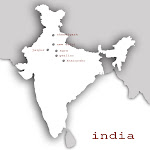


Although the journey to Chandigarh took up our entire day I was riveted to the sites out of the taxi window. I think that my dad didn't stop shooting video the entire trip. The driving in India is nothing short of orchestrated madness! The streets are filled with cars, trucks, motorcycles, rickshaws, bicycles, dogs, horses, cows, camels, and pretty much anything else that moves. Even the "highways" are filled with everyone and everything. The sounds of horns blaring fills the air as driver communicates with driver for their own piece of road. Moving through Delhi was pretty slow going - people are everywhere!
You can't help but be impressed by the shear amount of people in the city - even when you leave the city you never run out of people. Depending on what part of the city you are in you will see people of every economic station. Poverty is all around you. Groups of tents are patched together from pieces of trash, discarded cloth, old fabrics, rotten wood, sheet metal and any other material that can be scavenged forming their own communities. One such community was just outside of the city jail. As we drove by I noticed a woman siting in the dirt in the center median of the road, clothed with tattered rags. As we slowed I noticed a small child sitting in the dirt with her; mostly naked and covered in filth. My heart sank. For some reason I could almost cope with seeing adults in those conditions - but a child, a baby, it pretty much breaks your heart. You know they have no chance at what we call a normal life - what is normal anyway? Then in a flash we speed onward to more images of the same.
One of the other things that you notice is how dirty everything is - it seems to saturate the city with a blanket of dirt and garbage. I have never seen that amount of trash anywhere before in my life; well maybe at the local garbage dump. Trash can be seen deposited out of car and bus windows on a regular basis. It stacks up and begins to overtake the city. One of the only ways to try to rid the city of the garbage is to burn it. Fires silently smolder sending smoke softly into the atmosphere providing the city with a layer of smog that is so heavy that you see it, you feel it, and you quite certainly smell it.
Arriving in Chandigarh, you notice that the city is much cleaner than in Delhi. We were also greeted by one of a few "Open Hand" statues. The city was master-planned by Le Corbusier and I am very excited to experience the city and visit the government buildings tomorrow.












